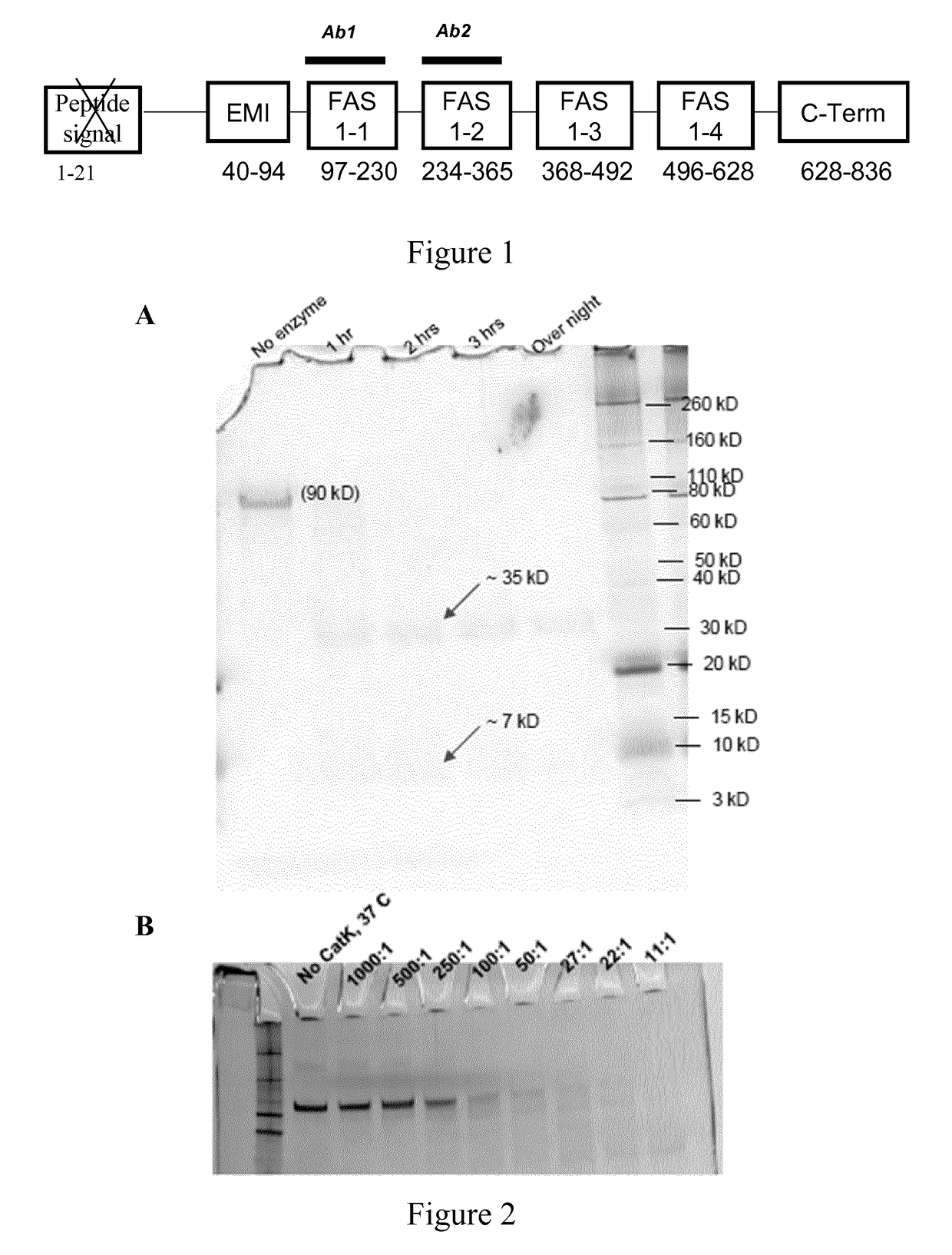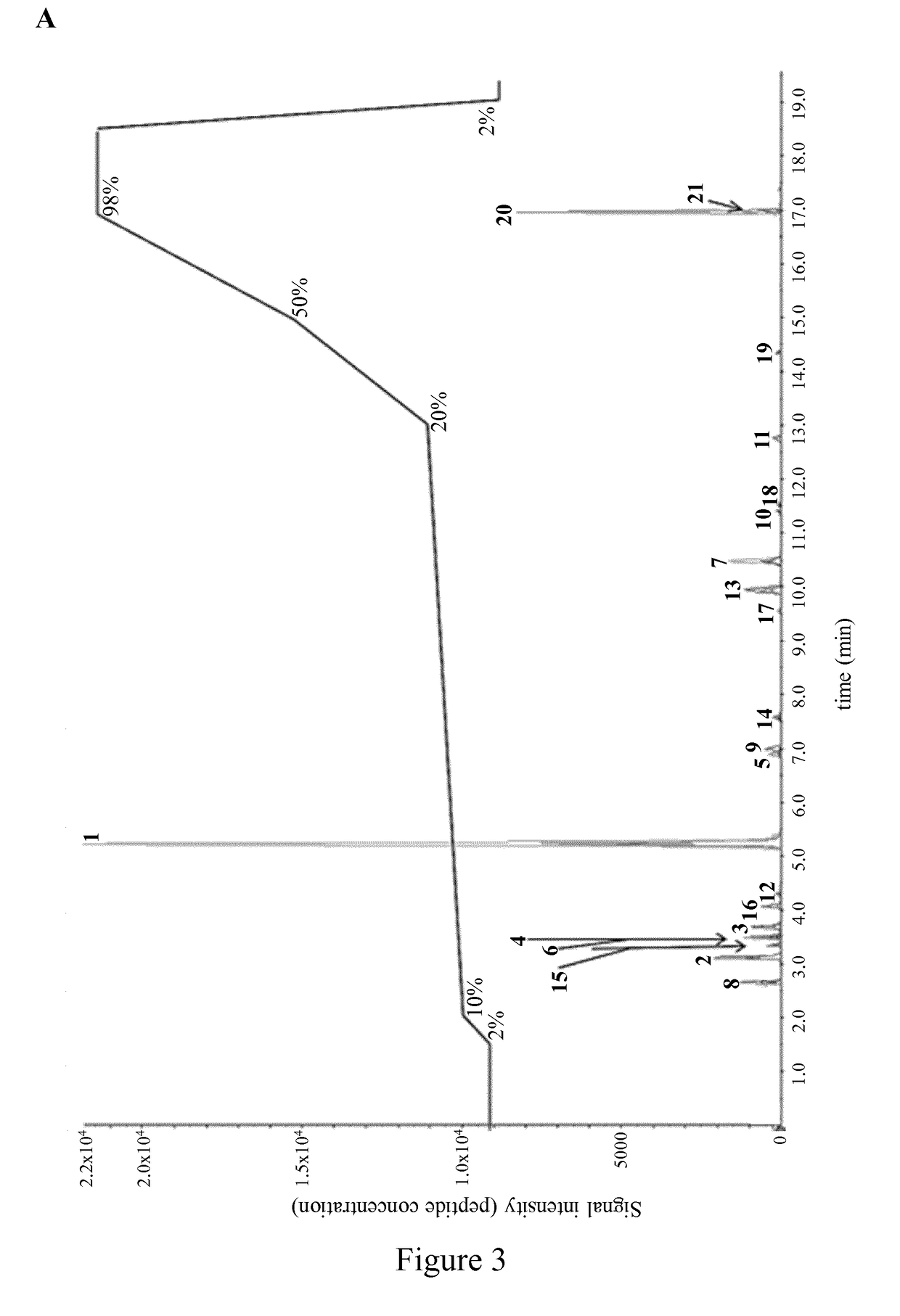Periostin fragments and use thereof
a technology of periostin and fragments, applied in the field of biological markers, can solve the problems of no anabolic agent able to increase trabecular bone formation, no biomarker offering an appropriate tool to monitor the effect of inhibitors on the remodeling activity of the trabecular/cortical compartmen
- Summary
- Abstract
- Description
- Claims
- Application Information
AI Technical Summary
Benefits of technology
Problems solved by technology
Method used
Image
Examples
example 1
CatK Digestion of Human POSTN
[0253]To identify the human POSTN fragments resulting from CatK dependent digestion lasting 1 h, 2 h, 3 h or overnight, polyacrylamide gel electrophoresis was used on POSTN protein sample mixed with an anionic detergent (sodium dodecyl sulfate) (SDS-PAGE).
[0254]CatK digestion, targeted LC-MS / MS and silver stained SDS-PAGE. Human recombinant POSTN (1.1 μM) was incubated with human CatK of SEQ ID NO: 19 (2.24 μM) at 37° C. Times and POSTN / CatK ratios are indicated for each protocol below. The inhibitor E64 (250 μM) was added to stop the digestion at the end of incubation. Then, the digests were analyzed by SDS-Page electrophoresis. Various POSTN fragments bands were excised from the SDS-Page gel and digested with trypsin. Then, the tryptic peptides were concentrated and separated by reverse phase chromatography on a PepMap100, C18, 5 μm, 100 Å, 300 μm×25 mm column from Dionex (ThermoScientific) using a gradient of 5 to 40% acetonitrile, 0.1% formic acid in...
example 2
Identification of POSTN Fragments
[0257]Several CatK-dependent POSTN fragments were separated and identified with the use of targeted liquid chromatography-tandem mass spectrometry (LC-MS / MS).
[0258]CatK digestion, targeted LC-MS / MS and silver stained SDS-PAGE as described in Example 1. Twenty-one different POSTN fragments were separated in a single LC-MS / MS analysis (FIG. 3A) which included peptides 1-17 which were further analysed below and peptide 18 (SEQ ID NO: 22), peptide 19 (SEQ ID NO: 23), peptide 20 (SEQ ID NO: 24) and peptide 21 (SEQ ID NO: 25). The most abundant CatK-digested POSTN fragments of SEQ ID NO: 2 and SEQ ID NO: 6 obtained at a ratio POSTN / CatK ranging from 250:1 to 5:1 were measured with LC-MS / MS. Absence of an incomplete digested POSTN fragment (ID SEQ NO.: 6) served as an indication of complete POSTN digestion at POSTN / CatK ratio of 5:1 (FIG. 3B).
[0259]This data show that the optimal in vitro digestion of human POSTN appears at POSTN / CatK ratio within a range o...
example 3
Time Course of CatK-Dependent POSTN Digestion
[0260]Time course of appearance of 17 CatK-dependent POSTN fragments obtained at POSTN / CatK ratio of 50:1, separated and identified with the use of LC-MS / MS, was evaluated.
[0261]CatK digestion, targeted LC-MS / MS and silver stained SDS-PAGE as described in Example 1. The appearance of 17 different POSTN fragments were monitored during CatK-dependent POSTN digestion between 15 min to 2 h, at POSTN / CatK ratio of 50:1 (FIG. 4). The earliest fragment is of SEQ ID NO: 2 appearing within 15 min from reaction start, followed by fragments of SEQ ID NO: 6, SEQ ID NO: 3, SEQ ID NO: 4, SEQ ID NO: 7 and SEQ ID NO: 5. Most of the POSTN digestion finishes within 60 min from the start of reaction.
[0262]Those 17 POSTN fragments were then ranked based on their abundance as measured in LC-MS / MS analysis, as well as speed of their generation (FIG. 5). Sequences of observed POSTN fragments suggest that amino acids K, T, E, R and L are preferred cleavage sites...
PUM
| Property | Measurement | Unit |
|---|---|---|
| temperature | aaaaa | aaaaa |
| pH | aaaaa | aaaaa |
| molecular weight | aaaaa | aaaaa |
Abstract
Description
Claims
Application Information
 Login to View More
Login to View More - R&D
- Intellectual Property
- Life Sciences
- Materials
- Tech Scout
- Unparalleled Data Quality
- Higher Quality Content
- 60% Fewer Hallucinations
Browse by: Latest US Patents, China's latest patents, Technical Efficacy Thesaurus, Application Domain, Technology Topic, Popular Technical Reports.
© 2025 PatSnap. All rights reserved.Legal|Privacy policy|Modern Slavery Act Transparency Statement|Sitemap|About US| Contact US: help@patsnap.com



